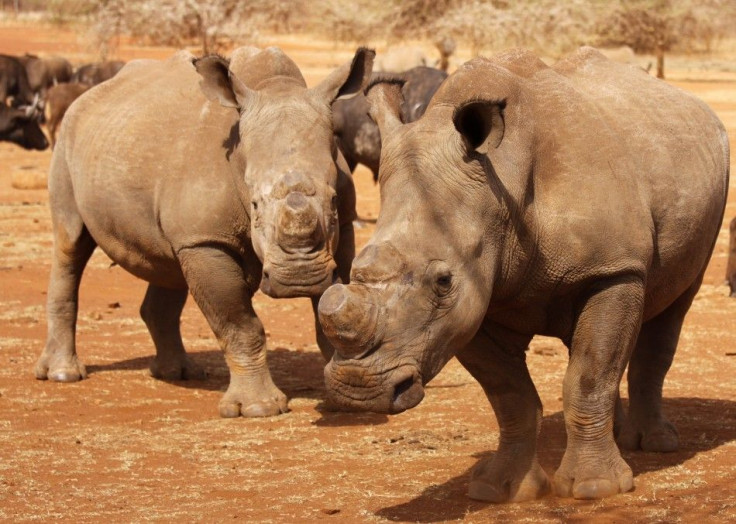South Africa Unveils A High-Tech Superman For Endangered Rhinos

South Africans looking to the skies in the coming months might see a strange object flying over the northeastern provinces of Mpumalanga and Limpopo.
Is it a bird? A plane? Or, upon closer inspection, a weird hybrid mix of drone and helicopter decked out in blue camouflage?
According to South African National Parks CEO David Mabunda, this is the Seabird Seeker, a high-tech reconnaissance craft whose sole mission is to protect the country’s endangered rhinoceroses from the poachers who kill for their horns.
On Tuesday, the Seabird Seeker was unveiled at a ceremony at Skukuza Airport in Kruger National Park, or KNP, a 7,500-square-mile reserve where 60 percent of the country’s rhinos -- an incredible 40 percent of the worldwide population -- are living.
“We anticipate that by the end of this calendar year, we will have lost about 650 rhinos throughout South Africa, 400 in the Kruger National Park,” said Mabunda at the ceremony. “To date, 588 rhinos have been lost to poaching, 364 in the KNP alone.”
It is now estimated that less than 20,000 rhinos remain in the country.
The Seabird Seeker was produced by Paramount Group, a private defense and aerospace firm based in South Africa. Ivor Ichikowitz, Paramount’s executive chairman, was there at KNP on Tuesday to kick off the rhino rescue program.
“Our world-class electronic systems technology brings expert navigation and surveillance solutions to the fore to help in the search for suspected rhino poachers throughout the Kruger National Park,” he said, according to a company press release.
"Advanced visual reconnaissance and surveillance will provide game reserve rangers with robust intelligence in their tireless mission to confront poachers."
A Paramount Group subsidiary called Ichikowitz Family Foundation donated Seabird Seeker to the South African National Parks. The vessel will employ infrared thermal imaging technology, making sure poachers have nowhere to hide. It can fly high or low, fast or slow, and visibility spans 270 degrees -- better than your average bird of prey.
If this all sounds like a military operation, it’s no coincidence. Paramount typically works with governments across the continent to provide state-of-the-art tools for surveillance, peacekeeping and myriad other defense projects. And South African officials know that in order to save the rhino population from an increasingly brazen crop of illegal poachers, a martial approach is in order.
“Enough is enough; the mindless slaughter of rhinos in the wild has called for a multi-pronged strategy,” Mabunda said. “We are actively enlisting and broadening our engagement with the private sector to protect and conserve wildlife. We will find the right solutions and fight this war.”
Things are bad, but they could be worse. The rhino population is still growing -- deaths, both natural and illegal, have not yet surpassed births. But if South Africa doesn’t take action right now, it will quickly reach that crucial tipping point where slow growth gives way to slow decline.
There are currently five species of rhino on Earth. Three are native to Asia, and the other two, black rhinos and white rhinos, call Africa their home. Both species come in shades of gray; their main difference is that black rhinos are smaller and tend to move independently rather than in herds.
Poaching has been a problem for decades now, especially for black rhinos. But the past few decades have seen increased conservation efforts that were paying off -- until recently.
International trade is at the heart of this problem. Asian countries have developed stronger relationships with South Africa and other emerging economies on the continent -- good news for the most part, except that rhino horns are in demand in many Asian countries for all the wrong reasons.
The powder of a ground rhinoceros horn is similar in composition to human fingernails, but urban legend has imbued it with magical properties. You’ll find different claims in China, Vietnam, Thailand and other Asian markets. Some say it can cure headaches, others report it can cure cancer, and still others think it prevents hangovers.
None of this is true, according to numerous scientific studies that have been done over the past several years. But old habits die hard. In some Asian markets, rhino horn isn’t worth its weight in gold -- it’s worth twice that.
The environmental risks are clear, but this is a social problem as well. Horn trading has spawned an increasingly sophisticated criminal industry. The established network has only encouraged crime, producing lucrative black markets and leading to higher levels of weapons possession. This poses a threat to communities in South Africa, where poverty is already rife and the opportunity for quick profit can be difficult to resist.
To combat this serious problem, national security forces will continue to play their part. Mabunda says that 246 suspected poachers and accomplices have already been arrested this year. The Seabird Seeker, he added, will be an extra boost to authorities.
“This surveillance solution gives our rangers just the right kind of support they need to win the war, and it brings us one step closer to ending the devastation of our rhinos."
© Copyright IBTimes 2024. All rights reserved.












